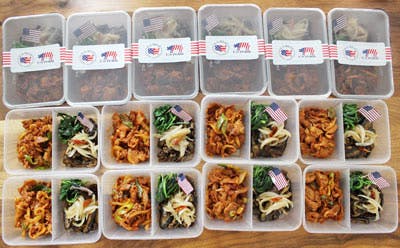U.S. Pork, Beef Featured in Korean Lunch Box Promotion

The winner of the U.S. Beef Lunch Box for Office Workers event enjoys U.S. beef with co-workers
USMEF recently launched a new promotion in South Korea to demonstrate the versatility of U.S. pork and beef and encourage consumers – especially young professionals – to incorporate the meats into their daily diets. U.S. meat lunch box events take advantage of Korea’s growing interest in social media to attract consumers and maintain a connection with them. Participants in USMEF lunch box events use Facebook to enter contests that award U.S. pork or beef lunch boxes to the winner and up to 20 colleagues. Funding for the events is provided by the Pork Checkoff, the Beef Checkoff Program and the USDA Market Access Program (MAP).
Mom's U.S. Pork Lunch Box featured popular Korean cooking instructor and USMEF pork model Jung Mi-kyung preparing lunch boxes with U.S. pork bulgogi and stir-fried U.S. pork and eggplant. The event attracted 140 participants and concluded with Jung personally delivering the lunch boxes to the winner.
U.S. Beef Lunch Box for Office Workers followed the same process. Lunch boxes with U.S. beef chuck flap tail steak and U.S. chuck eye roll, salad and other dishes were delivered to the workplace of the winner.

The Mom’s U.S. Pork Lunch Box featured U.S. pork bulgogi and stir-fried pork and eggplant
Both events resulted in valuable media coverage and positive exposure on Korean social media. The next lunch box event will take place in September, when Ricky Kim, USMEF-Korea’s beef model, will develop the menu and personally deliver lunch boxes to the winner.
USMEF-Korea Senior Manager for Public Relations Min Park said that developing new and unique approaches to promoting U.S. pork and beef is key to success in the market. Group and workplace meals are a good place to introduce menu ideas, she noted.

The beef lunch box featured U.S. beef chuck flap tail steak and chuck eye roll
“The percentage of U.S. pork and beef usage in Korea’s hotel, restaurant and institutional (HRI) sector is about 60 percent of imported volume, so housewives are not the only main target in the Korean market,” said Park. “Because of Korea's workplace dining culture – having meals together with colleagues for team building – office workers and the young generation in their 20s and 30s are an important target. USMEF Korea has been conducting various consumer events for this group, including a U.S. meat meal for college students' field trips and ‘after work’ dinner events for young professionals.”
